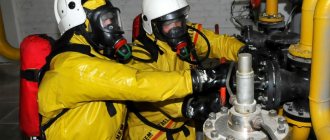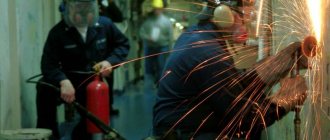High-risk jobs are types of work activities associated with special risks to the health of employees, to eliminate which a number of measures should be taken to ensure the safety of employees.
If necessary, our specialists will develop a list of high-risk works specifically for your enterprise!
Some industries and professions are more dangerous than others. Therefore, the protection of workers in hazardous conditions - in jobs that have a high risk for the health of workers - is an important element of labor protection measures.
Definition of hazardous work
From March 1, 2021, GOST 12.0.004-2015 began to apply. This document does not define high-risk work. However, it has been established that work performed in areas of possible or constant action of hazardous production factors is considered dangerous. At the same time, the indicated factors are not related to the nature of the work performed. That is, if, for example, a person works on a tower crane while building a house, then such a factor as “height” is a dangerous production factor.
Note that before starting high-risk work, the manager is required to develop and then implement additional safety measures for each specific production operation.
High-risk work does not include emergency situations.
What jobs are considered high-risk?
The list of high-risk work performed by employees of a particular organization depends on the specifics of the activities carried out by this organization. For example, in construction, high-risk work has one specificity, and in waste disposal, it has another specificity. Therefore, high-risk work and the organization of its implementation will differ in each specific case.
There is no exhaustive list of high-risk jobs. Therefore, here is a sample list:
- earthen in the area where underground gas and oil pipelines, energy networks and other similar underground facilities and communications are located;
- for digging trenches, pits deeper than 1.5 m;
- dismantling of structures and buildings;
- for the restoration and strengthening of damaged elements and parts of structures and buildings;
- installation, repair, construction, carried out in conditions of contact between the production activities of several teams (combined work);
- at a height above 2 m from the floor without the use of inventory scaffolding and scaffolding;
- repair of hot water and steam pipelines;
- for painting, roof repair, cleaning the roofs of buildings from dust or snow if there are no fences;
- for lowering, lifting and moving large and heavy cargo if there is no machine with the required carrying capacity;
- construction, repair and installation services for lighting fixtures;
- in limited spaces, in closed objects;
- for the maintenance of overhead cranes, if the work involves access to crane tracks;
- gas and electric welding inside and outside containers for flammable substances;
- in tanks, in closed tanks, in wells, in pits, in tunnels, in furnaces, in boiler chimneys and runners, where suffocation or poisoning of workers is possible;
- inside hot ovens;
- on opening and testing of pipelines and pressure vessels;
- for draining flammable acids, liquids and alkalis from railway tanks, if there are no equipped drain racks with mechanized means of draining;
- for repair and cleaning of air ducts, fans and filters of exhaust ventilation systems of chemical laboratories, electroplating shops, warehouses and other premises where potent radioactive, chemical and other hazardous substances are stored;
- repair of portable and stationary acetylene generators;
- repair and cleaning of crucibles and cyanide baths;
- at ammonia or oxygen compressor stations or pipelines;
- on transportation of potent poisons;
- for the destruction of waste alkali metals and potent poisons;
- maintenance of electrical installations on overhead or cable power lines;
- on carrying out gas hazardous work in the gas industry;
- for performing hot work in explosive areas;
- during the operation of heating networks and equipment, heat-using installations, etc.
List of working conditions with increased danger
According to current legislation, increased working conditions are:
- The work is top notch.
- Installation and dismantling of buildings, structures and their parts.
- Blasting and diving works.
- Work in electrical shops.
- Gas hazardous services (for example, installing a plug on a gas pipeline).
- Installation of power lines (as well as dismantling).
- Production related to the use of load-lifting cranes in places where there are many power lines and other electrical installations.
- In wells, pits, trenches and pits more than 2 m deep.
- Labor in logging (including transportation of timber and its rafting).
- Chemical and fire-resistant protection of wood and wooden products.
- Any types of working conditions related to construction, if there is a risk factor at this enterprise.
- If they are carried out close to the carriageway of roads or railways (determined in each specific case, taking into account the requirements of current legislation).
- Performing any actions in wells, pits, confined and hard-to-reach spaces.
- Work near flammable or combustible liquids.
- Glass melting.
- Chemical cleaning of equipment.
- Drilling of the wells.
- Installation of metal coatings.
- Disposal of weapons.
This is not the entire list of high-risk industries. In addition, even the entire list contains certain vague concepts, according to which it is necessary to determine whether there is a danger during the performance of a particular type of work on the spot, that is, in each specific case, taking into account the situation and conditions of production or performance of the functional duties of workers.
High-risk work without permission is not allowed
Work with increased danger must be carried out in accordance with the work permit. The permit is issued immediately before the start of such work. A work permit is an assignment for the execution of work. The document is drawn up on a special form. It must indicate:
- content of work;
- their location;
- start and end time;
- conditions for safe work performance;
- persons responsible for safety;
- brigade composition.
If you find an error, please select a piece of text and press Ctrl+Enter
.
Aimed at creating value or satisfying one's needs. Sometimes this is associated with a risk to life and health. Such work requires special permission and compliance with appropriate safety measures. Next, we will consider what is included in the list of types of work and professions of increased danger and their features.
Admission procedure
For certain types of hazardous conditions, a permit must be issued. This type of document establishes the content of these actions, the deadline for their implementation, the composition of the team that performs them, and also indicates the persons responsible for compliance with safety rules.
The permit is issued in accordance with a certain form. It is issued only for the period necessary to carry out these works.
When issuing a permit, a safety briefing for the entire team is required. It is issued in several copies:
- In two, one of which should be with the employee directly, and the other with the manager who is responsible for safety.
- Three, if the work is carried out on the territory of an existing enterprise. Then the third copy is given to the employee of this enterprise.
Any changes to the terms and conditions must be reflected in the relevant document.
general information
In any organization or enterprise there are types of activities that require special attention and approach, namely: high-risk work. Let's give them a definition.
Types of work in which an industrial hazard or the possibility of such may arise, regardless of the nature of the work. Occupational hazards are conditions under which there is a possibility of mechanical or chemical exposure to a worker when interacting with an object or things that have hazardous properties. A dangerous source includes natural forces that a person cannot resist.
From this we can conclude that the work may be of increased danger due to the nature of the material object at the time of its use or because of the nature of the work being done.
Therefore, when such types of work are to be carried out, it is necessary to adhere not only to safety conditions, but also to take additional measures that are developed for each production operation.
Who can be allowed to work?
Persons who:
- At least 18 years old.
- Have a medical certificate confirming their suitability for performing these hazardous jobs.
- Experience in this type of work is more than one year.
- Rank no lower than third.
- They know and are able to comply with the norms and rules of labor safety instructions.
- They have a certificate to perform this type of work.
- Completed safety training to perform the work.
If a worker performs work of such complexity and danger for the first time, he must be under the close supervision of workers with sufficient experience throughout the year. Responsible persons are appointed by special order.
Requirements for those responsible for the work
There are several employees who are responsible for performing hazardous work. Including:
- the one who issues the permit in the form of a work order
- management allowing a citizen to work
- employee who oversees the production process
- persons included in the team of hazardous work performers
It is the responsibility of the listed persons to undergo training. A mandatory element is checking the level of the obtained values. This applies to both safety and labor protection provisions. The employees who are entrusted with the responsibility for issuing permits determine when and what work should be carried out, and also choose which of the company employees will act as performers.
Also, the specified person is assigned the following functions:
- determination of conditions under which work is performed in a safe mode
- is engaged in the preparation of orders for the person responsible for supervising the work
The person in question is responsible for issues arising in the production activities. This concerns the correctness and completeness of the data that is reflected in the work order, the readiness of employees, and their training. The appointment takes place by issuing an order. An employee is selected from among the management team.
How is a permit issued?
Each enterprise has a list of high-risk work. The permit must be issued.
Design rules:
- Issued only for the time necessary to complete the work.
- Issued in two copies for each unit or brigade.
- Must be completed without corrections, clearly and accurately.
- In order to carry out work in the security zone of power lines or other utilities, permission must be obtained before issuing a permit to carry out such work.
- The issuance of work permits and returns are recorded in the accounting journal. In a journal, pages must be numbered. It itself is stitched and sealed.
- The permit is issued to the responsible person.
- A closed permit is stored for 30 days.
Rules for admission to hazardous work
Each enterprise has a list of high-risk work according to the work permit. Below are the rules that must be followed.
The responsible person is obliged to carry out the following actions:
The work contractor must perform the following duties:
- Check the availability of tools and protective equipment, as well as the preparation of the workplace and compliance with safety regulations.
- Determine each team member his workplace.
- Constantly be present during the work and monitor it taking into account safety standards.
- Do not allow team members to disturb the work and leave the work area.
- Take the team out for a break.
- Upon completion of the work, the work permit is signed and handed over to the responsible manager.
Carrying out work without a work permit
The legislation establishes a strict prohibition against working without the act in question. Once a person is given training, it provides them with information on how to work safely and protect themselves from hazards at work. Also, receiving this act helps to group moments of organizational and verification type.
If a company allows a citizen to work without the act in question, this indicates the possibility of applying penalties or termination of activities against it. Urban planning legislation states that upon the first such violation, a sanction of up to fifty thousand rubles is applied to the organization.
When this case has a fixed value, the enterprise is placed under special control. This is handled by Rostechnadzor. It is possible to file a complaint against a company that carries out activities without obtaining a permit or does not comply with the requirements of safety rules, not only by inspection bodies, but also by employees who demand compensation for moral damage.
Responsible persons
If it is necessary to issue a permit and perform work of increased complexity and danger, then, as a rule, the following persons are appointed as responsible persons:
- persons who issue permits;
- work managers;
- performers of work.
The manager himself can issue permission to perform a dangerous type of activity, thereby combining responsibilities. The manager can also be a responsible executive.
The contractor may be:
- foreman;
- master;
- brigade members.
Performers and managers, if their work involves danger, must have occupational safety certification.
Permission orders can be issued by persons who are authorized in accordance with the order. The list of high-risk work is certified by the chief manager of the enterprise.
Features of the organization and safe production of combined production facilities
The production of combined work is associated with the performance of the functional responsibilities of two work teams at one site or facility, the work areas of which are adjacent or even coincide. These are always construction and installation works that are associated with risk.
Organizing the safety of combined production activities is an important requirement for worker safety. The responsibility for organizing this process lies primarily with the general contracting organization, which is also responsible for the safety of workers of all organizations working in this area.
The manager must organize in such a way as to ensure the safety of all his employees, in particular, indicate to each team the construction sites that are their place of work.
Limits of responsibility
The responsible manager is responsible for:
- implementation of safety precautions;
- qualifications of the performer and team members;
- for access to the place of work.
The work contractor is responsible for:
- implementation of safety precautions by team members;
- for the safety of work;
- for the correct use of personal protective equipment;
- following the production process;
- maintaining discipline.
Work performers are responsible for:
- compliance with safety regulations;
- accurate implementation of instructions from responsible persons;
- mandatory use of personal protective equipment;
- compliance with production processes;
- compliance with technological discipline.
Security organization procedure
High-risk work involves the presence of a dangerous zone for people. For example, dismantling buildings or working with electrical equipment and acids. Therefore, even before work is carried out, hazardous areas must be clearly identified.
These are considered:
- The area near uninsulated live parts of equipment.
- Distance up to 2 meters from unfenced height differences of 1.3 meters or more.
- Plots next to a building under construction.
- Areas near structures that are being worked on.
- Territories of movement of machines, mechanisms, equipment.
- Areas over which loads are moved by a crane.
- Territories with equipment containing toxic, radioactive, chemical, flammable, hazardous substances.
- Places that contain chemical, hazardous, highly concentrated, harmful solutions that exceed permissible levels.
To prevent persons who are not involved in the work from entering hazardous areas, fences are installed. This is reflected in the admission certificate. The limits of hazardous areas are indicated in special tables. If there are none, they are installed by those responsible for organizing the work.
Professions of workers associated with hazardous working conditions
Professions that involve performing hazardous work include:
- Car driver.
- Electric and gas welder.
- A carpenter.
- Locksmith.
- Truck crane operator.
- Elevator.
- Firefighter.
- Forest feller.
List of high-risk production activities for which a work permit is required.
A permit is issued for certain types of hazardous work, namely:
- Gas-hazardous work , such as releasing gas into gas pipelines, refueling gas machines, repairing wells, draining gas from tanks, disconnecting from the existing network, purging gas pipelines, etc.
- Hot work , namely all types of gas welding and electric welding work using fire.
- Work in electrical installations , on cable and overhead power lines.
- Production related to the operation , use and repair of heat installations, heat-using installations.
- Work on overhead cranes.
- Electric welding.
- Activities involving chemicals (eg toxic substances).










